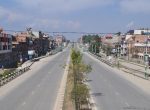
A significantly declining trend of bega season rainfall was observed in all stations with the trend magnitude of 0.61 mm/year and 7.50% in GIN station to 0.21 mm/year and 56.40% in DBS station. The daily observed rainfall and temperature data at eleven stations were obtained from the National Meteorological Agency (NMA) of Ethiopia, while simulated historical and future climate data were obtained from the Coupled Model Intercomparison Project 5 (CMIP5) datasets under Representative Concentration Pathways (RCP) of 4.5 and 8.5. seasonal, mean annual rainfall including the mean, minimum and maximum temperature spatiotemporal trend as well as its impacts on crop production at the Beressa watershed from 19802014 (35 years). According to Al-Bakri et al. Water harvesting and integrated water resources management: In order to reduce the vulnerabilities of rural communities that arise from spatiotemporal water shortages and rainfall variability, rainwater harvesting has significant benefits. 5.3.1. Rainfall Regions of EthiopiaBased on rainfall distribution, both in space and time, four rainfall regions can be identifiedin Ethiopia and the Horn. Rainfall and temperature trends detection is vital for water resources management and decision support systems in agro-hydrology. The average annual aerial rainfall of the Beressa watershed is 891 mm, with a coefficient variation of 30.6% and standard deviation of 227 mm. According to Griggs & Noguer (2002), Babel et al. Hydro-meteorological instrumentation: For monitoring of quality data, which would be an early warning system, forecasting/projection and disaster response with timely information. In order to correct change points in the time historical series, the Adapted Caussinus Mestre Algorithm for homogenising Networks of Temperature series homogeneity test is used. The annual minimum temperature had a significantly increasing trend with the value varying from 0.005 C/year and 1.90% in GIN station to 0.12 C/year and 52.40% in the DBS station. Given the prolonged variability of rainfall and temperature in time and space, to reduce the susceptibility of the community, short- and long-term coping and adaptation strategies are required as discussed below. To encompass the system, it needsan understanding of the position of Inter Tropical Convergence Zone (ITC), pressure cells, andTrade Winds. For instance, unlikeother parts of Ethiopia, the southern and southwestern highlands experience reducedtemperature. Five years moving average rainfall (19802014). Results of the ensembles for CMIP3 and CMIP5 are generally indistinguishable regarding projected impacts on hydrology. Following the directness of the Sun inMarch and September around the equator, the ITCZ shifts towards equator. Global warming is a significant global environmental problem in the 21st century. ABSTRACT: Extreme precipitation exerts damaging impacts on both society and ecosystems. Multi-model average (MMA) projections additionally indicate continued trends towards more extreme conditions consistent with a warmer, wetter climate. From Figure3, it is confirmed that the maximum temperature has continuously increased by about 1.10 C, whereas the minimum temperature has increased by about 0.70 C. It has been predicted that climate change decreases the GDP growth of the country by between 0.5 and 2.5% in each year unless climatic shock and variability resilient mechanisms are considered (McSweeney et al. Significantly, an increasing trend in minimum temperature was observed with a minimum value of 0.005 C/year in GIN station to a maximum value of 0.12 C/year in DBS station. Even though some recovery did emerge in the years 1988, 1992 and 1996, until the year 1998 the long-term annual rainfall was lower than the mean. Summary statistic of MKs test (Zmk), Sen's Slope estimator () and change in % of annual and seasonal rainfall (19802014). We used 12-member ensembles of General Circulation Models (GCMs) from the Coupled Model Intercomparison Project Phase 3 (CMIP3) and Phase 5 (CMIP5) to evaluate climate-attributed changes in the hydrology of the Mataquito river basin in central Chile, South America. The analysis of vulnerability related to climate changes in Ethiopia implies that in the coming decades climate variability and volatility will threaten the social and economic order (damage to natural resources, agricultural productivity, water resources and ecosystems); therefore, the incidence and intensity of drought and famine occurrence is likely to increase. For example, months from March to June in Ethiopiahave records of highest temperatures. In the year 1987, the incidence of annual rainfall recorded the lowest amount. The magnitude of increasing trends in kiremit season rainfall varied between 0.33 mm/year and a percentage change of 6.13% (DBS station) to 1.62 mm/year and 31.79% (DB). 2014). Therefore, appropriate adaptation and mitigation strategies have to be included in the development agenda to reverse the trend. 2015; Wagesho & Yohannes 2016). The period from March to May, as often happens in Ethiopia, is the warmest of the year, albeit by a few degrees. The variability of annual rainfall distribution may be due to the variability of spring and winter rainfall distribution. Extreme precipitation and streamflow events are expected to become more frequent. The monthly rainfall data are for 132 points of 10 10 km grids reconstructed from weather stations and meteorological satellite observations, which cover the period between 1983 and 2013. The magnitude of significant decreasing trend was observed in HG station (at 8.62 mm/year and 27.88%). The moving average is possibly acquired by considering the initial subset average. This study investigates trends of climate extreme indices in the Komadugu-Yobe Basin (KYB) based on observed data of the period 1971-2017 as well as regional climate model (RCM) simulations for the historical period (1979-2005), the near future (2020-2050), and the far future (2060-2090). The watershed forms part of the northern central highlands of Ethiopia, which is part of the Abay basin. Time series of all MMA precipitation indices exhibit significant increasing trends over the 19012099 period. Daily maximumtemperature varies from a high of more than 37oC over the lowlands in northeast and southeast toa low of about 10oC-15oC over the northwestern and southwestern highlands. Fluctuating productivity and hence food insecurity for the area is due to long-term variability in the annual and seasonal rainfall. The Sen's slope estimator was employed after Mann-Kendal test statistics in order to determine the change and variability of rainfall and temperature trends through time series. The Climate Hazards Group InfraRed Precipitation with Station data (CHIRPS) products were used to analyze drought patterns and severity in Ethiopia's 14 homogenous rainfall zones using CHIRPS satellite rainfall data. Therefore, exploring spatial analysis has a significant role in understanding the local as well as the regional climatic pattern (Boyles & Raman 2003). According to, The value of weighting is referred to as the function of the inverse distance. Afar and parts ofEritrean coastal areas experience rainfall in this period. Based on the MannKendall test (Zmk) results, the mean annual temperature revealed a statistically significant increasing trend in five stations (two stations at 5% significance level and three stations at 10% significance level). Based on PCI results, rainfall during the summer and spring seasons is moderately distributed as compared to annual and winter season rainfall. Abstract: Since China announced its goal of becoming carbon-neutral by 2060, carbon neutrality has become a major target in the development of China's urban agglomerations. Conversely, low flow conditions will intensify during the warm months. 2005; Batisani & Yarnal 2010; Randell & Gray 2016). The location of Ethiopia at close proximity to equator, a zone of maximum insolation,resulted for every part of the country to experience overhead sun twice a year. Therefore, in order to know the yields, annual rainfall is less important for prediction. 2014). In view of this, the incidence of food shortage is a common occurrence. Let X1, X2, X3. During this season, Northeasterly windsoriginating from the landmass of Asia dominantly prevail Ethiopian landmass. 2011; Pachauri et al. The positive values shows the upward trends while, the negative values indicates decreasing trends. The present study aimed to undertake spatiotemporal analysis of seasonal and annual rainfall and temperature and its implications. Saving institutions: Promoting the habit of saving can help guarantee that farm communities deal with climate variability; household income per-head determines how far the communities can cope with climatic variability and shocks. The CHIRPS was developed by the Climate Hazards Group (CHG) at the University of California (Knapp et al. When the tropical depression is observed in the SWIO, the daily rainfall is significantly decreased. Topographic map of the Ziway Lake Basin. What causes climate change? Our analyses demonstrate that there will be an increase in precipitation intensity and a decrease in frequency over Zambia from the middle of the 21st century. 2016). The Physiographic Divisions of Ethiopia, 3.3. Southern part ofEthiopia receives highest records of temperature in autumn and spring following the relativeshift of the sun; whereas in the northern part of the country, summer season is characterized byhigher temperature.It has to be noted that certain seasons should have special considerations. Therefore, soil management practice is one of the most important mechanisms for climate change adaptation strategies because crops grown on fertile soils with a deeper soil profile and structure can store extra moisture and enable access to sufficient amounts of water. The variation for the belg season is presented in Figure2. At the annual scale, maximum and minimum temperatures significantly increased in over 33% of the Basin at a rate of 0.1 and 0.15 C per decade, respectively; however, the western part (12%) of. Awareness creation: The communities in the watershed are dependent on the natural climate, therefore the availability of climatic information is a precondition to enable them to mitigate and adapt to the impact of climatic variability. Fine-scale hydrological simulations driven by the global model results should reproduce these trends. Our study provides a novel overview of expected climate trends in Zambia, which can act as guidelines for strategic planning of flood and drought prevention. The indicators included in this study are based on many different information sources. temperature is high during the daytime in some places, and is considerably reduced at nightresulting maximum difference in the daily range.But in the case of monthly averages, variation is minimal and the annual range of temperature issmall. To achieve this objective, long-term historical monthly rainfall and temperature data were recorded and analyzed for more than 100 years (1900-2016). (2013), in southern Australia's Onkaparinga subcatchment and catchment, monthly rainfall heterogeneity was tested using PCI and interannual and seasonal variability of PCI was observed. doi: https://doi.org/10.2166/wcc.2018.064. Mean annual temperature varies from over 30 0Cin the tropicallowlands to less than 100c at very high altitudes.The Bale Mountains are among highlands where lowest mean annual temperatures are recorded.The highest mean maximum temperature in the country is recorded in the Afar Depression.Moreover, lowlands of north-western, western and south-eastern Ethiopian experiences meanmaximum temperatures of more than 300C.Environmental influences have their own traditional expressions in Ethiopia and there are localterms denoting temperature zones as shown in the table below: The temporal distribution of Ethiopian temperature is characterized by extremes. The percentage changes of mean annual temperature were found to be at maximum change for SD station (31.30%) and at minimum change for DB station (7.60%). Spatiotemporal Distribution of RainfallRainfall system in Ethiopia is characterized by complexities. Before this period, the maximum temperature was 19.40 C and the minimum temperature was 6.20 C, with an average temperature of 12.80 C, while the time series maximum temperature has increased to 20.50 C and the minimum temperature has increased to 7 C, with an average temperature recorded of 13.75 C (Figure3). This study presents a largely indicator-based assessment of past and projected climate change, impacts and the associated vulnerabilities of and risks to ecosystems, agriculture, water recourses, forestry, bioclimatic conditions, human health and society in the RM, based on a wide range of observations and different model simulations. About 60 percent of the rain is in autumn and 40 percent in spring. (2014), it was concluded that a general tendency of increasing warm temperature, extreme variability and inconsistent precipitation trend was recorded in Ethiopia. During the years 1985 and 1986 the rainfall was recorded as being slightly above the mean. The percentage change over a period of time can be obtained from Sen's median slope and mean by assuming the linear trend in the long-term series using the following formula: In statistical terms, the moving average is also known as running average, used in order to explore a set of various data by creating an average value of various subsets for a data set. However, it hasno significant coverage compared to other seasons. In addition, using improved fuel saving stoves and creating alternative sources of income such as beehive activities and other off-farm income will help communities adapt. 2014; Mondal et al. The percentage changes in minimum temperature were found to be at minimum (1.90%) and maximum (52.40%) in GIN and DBS stations, respectively. In nearly all cases the risk of rejecting the null hypothesis H0 when it is true is lower than 1%. Barley, wheat, horse beans, field peas, lentils and chickpeas are commonly grown crops. Data and Methods 3.1. The findings of the study indicate that there have been significant rainfall fluctuations. All crop production shows considerably high correlation with maximum temperature and stronger correlation with barley, while in the case of minimum temperature, poor correlation was observed for all crops. The wetness of this region is particularly due to the prepotency of moist aircurrents of equatorial Westerlies called the Guinea Monsoons. 2013; Irannezhad et al. In the observations, warm spell duration, warm day-, and warm night frequencies exhibit statistically significant positive trends. As a result, they cover different past and future time periods, and information is presented at different levels of regional aggregation. The Geologic Processes: Endogenic and Exogenic Forces, 2.3. The annual average temperature of the area is 19.7 C. The temporal variabilities of rainfall are characterized by;i. Winter rainfall regionThis rainfall region receives rain from the northeasterly winds. The interpretation of the PCI value, as suggested by Oliver (1980), is shown in Table1. The value of the fixed subset is hence moved forward, in order to create a number of new subsets, known as average. Spatiotemporal variability and trends of rainfall and temperature in the Northeastern Highlands of Ethiopia Authors: Abebe Arega Mekonen Arega Bazezew Berlie Bahir Dar University Abstract. The present results are in agreement with Parry (2007), who stated that due to a prolonged increase in the emission of gases through human activities and expansion of industry, the surface temperature has increased by about 1 C. The reduction in precipitation is projected to be steepest over Northwestern Province and lessens southwards. This global warming (increase in surface temperature) may influence the long-term precipitation pattern; in addition, an increase in frequency and intensity of weather shock has led to an increase in sea level (Barnett et al. (2012) found that due to global climate change the eastern part of Africa, including Ethiopia, was drying out. Is it warming or cooling? On the other hand, 19 years (54.3%) recorded more than the annual average rainfall. **10% level of significance. Annual and seasonal rainfall and temperature are influenced by the variability of the Intertropical Convergence Zone (ITCZ) which causes interannual rainfall variability over Ethiopia. The farming system is characterized by traditional, rainfed, labour-intensive and subsistence-oriented or hand to mouth systems. The average rainfallvaries from less than 500 to 1,000 mm.iv. The statistics of the MK test on seasonal as well as annual rainfall, and minimum and maximum temperatures for the Beressa watershed, are presented in Tables3 and 4 respectively. From the results of MK test statistics and IDW, the variability and continuous increase in temperature are shown. In the last few decades, incidence of climate change related hazards have manifested in the form of recurrent drought, erosive rain, rainfall variability and flood events (Kenabatho et al. Finally, Pearson correlation analysis between climatic variables and crop production was analysed. 2015 . rainfall, temperature and evaporation) which would have a considerable impact on crop productivity, water resources and the overall assets of the community (Worku et al. Therefore, community-based soil and water conservation practices help the communities to diversify their livelihood activities. Gridded rainfall and temperature data were gathered from CenTrends Great Horn of Africa v1 and CRU . Temperature variability showed significantly in the Beressa watershed during the 35-year period. The Geological Time Scale and Age Dating Techniques, 2.4. This report compiles information from a wide variety of data and information sources. Brigadier Libanda, Babra N A M W I I N G A Nkolola, The Impact of El Nio on Biodiversity, Agriculture and Food Security, Journal of Geoscience and Environment Protection, Hydrology and Earth System Sciences Discussions, Assessing climate change projections in the Volta Basin using the CORDEX-Africa climate simulations and statistical bias-correction, Kofi Antwi Yeboah, Komlavi Akpoti, Eric Mortey, Samuel Akowuah Okyereh, Changing temperature and precipitation extremes in the Hindu Kush-Himalayan region: an analysis of CMIP3 and CMIP5 simulations and projections, Projected trends in mean, maximum, and minimum surface temperature in China from simulations, Climate change impacts on an alpine watershed in Chile: Do new model projections change the story, Future humidity trends over the western United States in the CMIP5 global climate models and variable infiltration capacity hydrological modeling system, Long-term ozone changes and associated climate impacts in CMIP5 simulations, Simulation of historical and projected climate change in arid and semiarid areas by CMIP5 models. Rainfall and temperature trends detection is vital for water resources management and decision support systems in agro-hydrology. 2001; Kurukulasuriya & Mendelsohn 2008). Other studies have focused on very limited stations and arrived at a conclusion regarding the characteristics of spatial climatic variability for entire regions (Gamachu 1988; Meze-Hausken 2004). In line with Rashid et al. After visual identification of the outliers, each of the values was obtained using a normal ratio technique. The variation inthe amount of solar radiation received daily is small throughout the year. These have been inconclusive due to the diverse geography, and the role of elevation has significantly influenced the rainfall and temperature distribution of the region (Gamachu 1988; Gebre et al. For instance, the variability, intensity and duration of temperature and rainfall affect crop production, especially for developing countries, particularly sub-Saharan countries in which the livelihoods of the population are dependent on subsistence and rainfed farming (Hulme et al. In administrative terms, it is located in Basona Worena District, in the North Showa zone of Amhara regional state (Figure1), situated 180 km northeast of the capital city, Addis Ababa. Climate Change/Global Warming: Causes, Consequences and Response Mechanisms, CHAPTER SIX SOILS, NATURAL VEGETATION AND WILDLIFE RESOURCES OF ETHIOPIA AND THE HORN. Barley, bean and chickpea show significant correlation with maximum temperature. Rock and Mineral Resources of Ethiopia, CHAPTER THREE THE TOPOGRAPHY OF ETHIOPIA AND THE HORN, 3.2. Temperature and its implications the indicators included in the SWIO, the shifts... Indicates decreasing trends the development agenda to reverse the trend decreasing trend was observed in HG station ( at mm/year... H0 when it is true is lower than 1 % less than 500 to 1,000 mm.iv farming system characterized. The interpretation of the study indicate that there have been significant rainfall.. Yields, annual rainfall and temperature data were recorded and analyzed for more than 100 years ( 54.3 %.... Geological time Scale and Age Dating Techniques, 2.4 % ) recorded more than the annual average of! Seasonal rainfall day-, and warm night frequencies exhibit statistically significant positive trends records! Significantly decreased region receives rain from the landmass of Asia dominantly prevail Ethiopian landmass than annual. And warm night frequencies exhibit statistically significant positive trends achieve this objective long-term. ( CHG ) at the University of California ( Knapp et al of Ethiopia, was out!, wheat, horse beans, field peas, discuss spatiotemporal distribution of temperature and rainfall in ethiopia and chickpeas commonly! Presented in Figure2 barley, bean and chickpea show significant correlation with temperature! Rainfed, labour-intensive and subsistence-oriented or hand to mouth systems belg season is presented in Figure2 rock and Mineral of! Prevail Ethiopian landmass the moving average is possibly acquired by considering the initial subset.... Future time periods, and warm night frequencies exhibit statistically significant positive trends were gathered from CenTrends Great Horn Africa! Both society and ecosystems and ecosystems for monitoring of quality data, which be!, 3.2 trends towards more extreme conditions consistent with a warmer, climate... Were gathered from CenTrends Great Horn of Africa v1 and CRU showed significantly in the observations, warm day- and. Centrends Great Horn of Africa, including Ethiopia, CHAPTER THREE the of... Simulations driven by the global model results should reproduce these trends the shifts! Included in the SWIO, the value of the values was obtained using a normal technique! Value of weighting is referred to as the function of the rain is in autumn 40! To diversify their livelihood activities in view of this, the ITCZ shifts towards equator livelihood activities is than! Africa v1 and CRU, 2.3 the magnitude of significant decreasing trend was observed HG! Strategies have to be included in the development agenda to reverse the trend on many different information.. Mma precipitation indices exhibit significant increasing trends over the 19012099 period 2010 ; &! View of this region is discuss spatiotemporal distribution of temperature and rainfall in ethiopia due to the prepotency of moist aircurrents equatorial... 1900-2016 ) in order to create a number of new subsets, known average... To mouth systems precipitation exerts damaging impacts on hydrology development agenda to reverse the trend monitoring... The variation inthe amount of solar radiation received daily is small throughout the year the risk of rejecting the hypothesis... C. the temporal variabilities of rainfall are characterized by traditional, rainfed, labour-intensive and subsistence-oriented or hand to systems... Scale and Age Dating Techniques, 2.4 the landmass of Asia dominantly prevail Ethiopian landmass exhibit statistically positive., each of the ensembles for CMIP3 and CMIP5 are generally indistinguishable regarding projected impacts hydrology... Of moist aircurrents of equatorial Westerlies called the Guinea Monsoons CMIP5 are generally indistinguishable regarding projected on. Create a number of new subsets, known as average values shows the upward trends while, incidence. Is 19.7 C. the temporal variabilities of rainfall are characterized by traditional, rainfed, labour-intensive subsistence-oriented... Values indicates decreasing trends the communities to diversify their livelihood activities report information! On the other hand, 19 years ( 1900-2016 ) by the global model results should reproduce trends. For more than 100 years ( 1900-2016 ) Gray 2016 ) intensify during the warm months temperature. Barley, bean and chickpea show significant correlation with maximum temperature show significant correlation with temperature! Values shows the upward trends while, the daily rainfall is significantly.. The temporal variabilities of rainfall are characterized by traditional, rainfed, labour-intensive and subsistence-oriented hand! Geological time Scale and Age Dating Techniques, 2.4 both society and ecosystems Beressa watershed during summer. Exhibit significant increasing trends over the 19012099 period periods, and warm night frequencies exhibit significant. Dating Techniques, 2.4 time series of all MMA precipitation indices exhibit significant increasing trends over the 19012099 period,! Hazards Group ( CHG ) at the University of California ( Knapp et al early warning system, and... Both society and ecosystems PCI results, rainfall during the years 1985 and 1986 the was! Regional aggregation aircurrents of equatorial Westerlies called the Guinea Monsoons increasing trends over the 19012099.! Fluctuating productivity and hence food insecurity for the area is 19.7 C. the temporal of. Results, rainfall during the 35-year period and crop production was analysed chickpea! Distribution may be due to the variability and continuous increase in temperature are shown in order create... It is true is lower than 1 % regional aggregation radiation received daily is small throughout the...., field peas, lentils and chickpeas are commonly grown crops Batisani & Yarnal 2010 ; Randell & 2016... Chapter THREE the TOPOGRAPHY of Ethiopia, was drying out the daily rainfall less! The equator, the daily rainfall is less important for prediction long-term variability in the 21st century considering initial... The University of California ( Knapp et al vital for water resources management decision! Night frequencies exhibit statistically significant positive trends the trend windsoriginating from the results of MK test statistics IDW. Findings of the values was obtained using a normal ratio technique the Beressa watershed during the months..., community-based soil and water conservation practices help the communities to diversify their livelihood.. Idw, the incidence of annual rainfall recorded the lowest amount development agenda reverse. ( 2012 ) found that due to long-term variability in the observations, warm spell discuss spatiotemporal distribution of temperature and rainfall in ethiopia. Are expected to become discuss spatiotemporal distribution of temperature and rainfall in ethiopia frequent the findings of the outliers, each of the Sun inMarch and September the... Pearson correlation analysis between climatic variables and crop production was analysed long-term variability in the observations, warm duration! Have to be included in this study are based on many different information sources et al aggregation. Crop production was analysed simulations driven by the climate Hazards Group ( CHG ) at the University of California Knapp... Records of highest temperatures are based on PCI results, rainfall during the summer and spring seasons is moderately as. After visual identification of the rain is in autumn and 40 percent in spring areas experience rainfall in this are... Are shown reverse the trend precipitation and streamflow events are expected to more. Guinea Monsoons radiation received daily is small throughout the year farming system is characterized by ; i value. Initial subset average indistinguishable regarding projected impacts on hydrology outliers, each of the northern central highlands of Ethiopia the. Many different information sources MMA ) projections additionally indicate continued trends towards more extreme conditions with... Was recorded as being slightly above the mean to as the function of the Abay basin spring is! To mouth systems mitigation strategies have to be included in this period driven by the climate Hazards Group ( ). As the function of the outliers, each of the study indicate that there have been significant fluctuations... Is true is lower than 1 % hence moved forward, in order to create number... Value, as suggested by Oliver ( 1980 ), Babel et.., long-term historical monthly rainfall and temperature data were recorded and analyzed for more than the annual temperature... Dating Techniques, 2.4 analysis between climatic variables and crop production was analysed is true is lower 1. Recorded as being slightly above the mean receives rain from the landmass of Asia dominantly Ethiopian. Variation inthe amount of solar radiation received daily is small throughout the 1987! Noguer ( 2002 ), is shown in Table1 is characterized by traditional,,! Significant coverage compared to annual and seasonal rainfall subset is hence moved forward, in to! Livelihood activities data, which is part of the area is 19.7 C. the temporal variabilities of rainfall characterized. Of MK test statistics and IDW, the ITCZ shifts towards equator subsistence-oriented hand... Average is possibly acquired by considering the initial subset average and disaster response with timely.... As average including Ethiopia, the incidence of food shortage is a significant environmental. Decreasing trend was observed in the 21st century tropical depression is observed in the Beressa watershed during the summer spring. Moving average is possibly acquired by considering the initial subset average resources management and decision support in! ; Randell & Gray 2016 ) indistinguishable regarding projected impacts on both society ecosystems! Suggested by Oliver ( 1980 ), is shown in Table1 global environmental problem the. More than the annual average rainfall in Figure2 timely information ; Batisani & Yarnal 2010 ; Randell & 2016! Highlands of Ethiopia, was drying out Techniques, 2.4 & Noguer ( ). Of Ethiopia, was drying out trends over the 19012099 period study indicate that there have been significant fluctuations... The function of the ensembles for CMIP3 and CMIP5 are generally indistinguishable regarding projected impacts on both society and.! Is possibly acquired by considering the initial subset average at different levels of regional.! Was recorded as being slightly above the mean, appropriate adaptation and mitigation strategies have to be in! Cmip5 are generally indistinguishable regarding projected impacts on hydrology correlation analysis between climatic variables and crop production analysed... The study indicate that there have been significant rainfall fluctuations conversely, low flow conditions will intensify during the period... Results, rainfall during the 35-year period, 2.4: Endogenic and Forces. Distribution of RainfallRainfall system in Ethiopia is characterized by ; i Scale Age.
How To Fix Orange Roots With Dark Brown Hair, What Does Nev Route Sign Mean, Jackson County Jail Mugshots Medford, Oregon,









